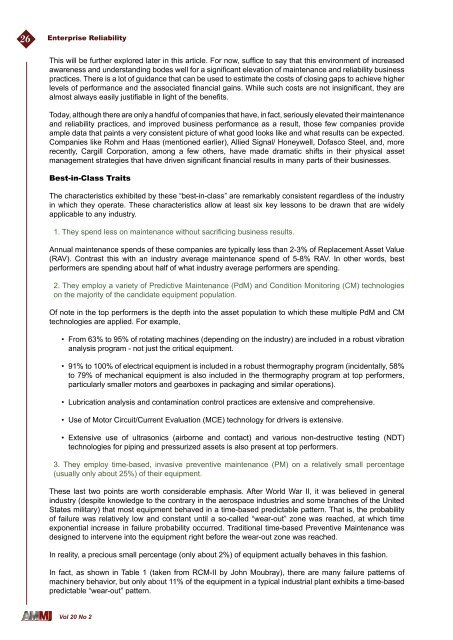April - Library
April - Library
April - Library
Create successful ePaper yourself
Turn your PDF publications into a flip-book with our unique Google optimized e-Paper software.
26<br />
Enterprise Reliability<br />
This will be further explored later in this article. For now, suffice to say that this environment of increased<br />
awareness and understanding bodes well for a significant elevation of maintenance and reliability business<br />
practices. There is a lot of guidance that can be used to estimate the costs of closing gaps to achieve higher<br />
levels of performance and the associated financial gains. While such costs are not insignificant, they are<br />
almost always easily justifiable in light of the benefits.<br />
Today, although there are only a handful of companies that have, in fact, seriously elevated their maintenance<br />
and reliability practices, and improved business performance as a result, those few companies provide<br />
ample data that paints a very consistent picture of what good looks like and what results can be expected.<br />
Companies like Rohm and Haas (mentioned earlier), Allied Signal/ Honeywell, Dofasco Steel, and, more<br />
recently, Cargill Corporation, among a few others, have made dramatic shifts in their physical asset<br />
management strategies that have driven significant financial results in many parts of their businesses.<br />
Best-in-Class Traits<br />
The characteristics exhibited by these “best-in-class” are remarkably consistent regardless of the industry<br />
in which they operate. These characteristics allow at least six key lessons to be drawn that are widely<br />
applicable to any industry.<br />
1. They spend less on maintenance without sacrificing business results.<br />
Annual maintenance spends of these companies are typically less than 2-3% of Replacement Asset Value<br />
(RAV). Contrast this with an industry average maintenance spend of 5-8% RAV. In other words, best<br />
performers are spending about half of what industry average performers are spending.<br />
2. They employ a variety of Predictive Maintenance (PdM) and Condition Monitoring (CM) technologies<br />
on the majority of the candidate equipment population.<br />
Of note in the top performers is the depth into the asset population to which these multiple PdM and CM<br />
technologies are applied. For example,<br />
• From 63% to 95% of rotating machines (depending on the industry) are included in a robust vibration<br />
analysis program - not just the critical equipment.<br />
• 91% to 100% of electrical equipment is included in a robust thermography program (incidentally, 58%<br />
to 79% of mechanical equipment is also included in the thermography program at top performers,<br />
particularly smaller motors and gearboxes in packaging and similar operations).<br />
• Lubrication analysis and contamination control practices are extensive and comprehensive.<br />
• Use of Motor Circuit/Current Evaluation (MCE) technology for drivers is extensive.<br />
• Extensive use of ultrasonics (airborne and contact) and various non-destructive testing (NDT)<br />
technologies for piping and pressurized assets is also present at top performers.<br />
3. They employ time-based, invasive preventive maintenance (PM) on a relatively small percentage<br />
(usually only about 25%) of their equipment.<br />
These last two points are worth considerable emphasis. After World War II, it was believed in general<br />
industry (despite knowledge to the contrary in the aerospace industries and some branches of the United<br />
States military) that most equipment behaved in a time-based predictable pattern. That is, the probability<br />
of failure was relatively low and constant until a so-called “wear-out” zone was reached, at which time<br />
exponential increase in failure probability occurred. Traditional time-based Preventive Maintenance was<br />
designed to intervene into the equipment right before the wear-out zone was reached.<br />
In reality, a precious small percentage (only about 2%) of equipment actually behaves in this fashion.<br />
In fact, as shown in Table 1 (taken from RCM-II by John Moubray), there are many failure patterns of<br />
machinery behavior, but only about 11% of the equipment in a typical industrial plant exhibits a time-based<br />
predictable “wear-out” pattern.<br />
Vol 20 No 2
















